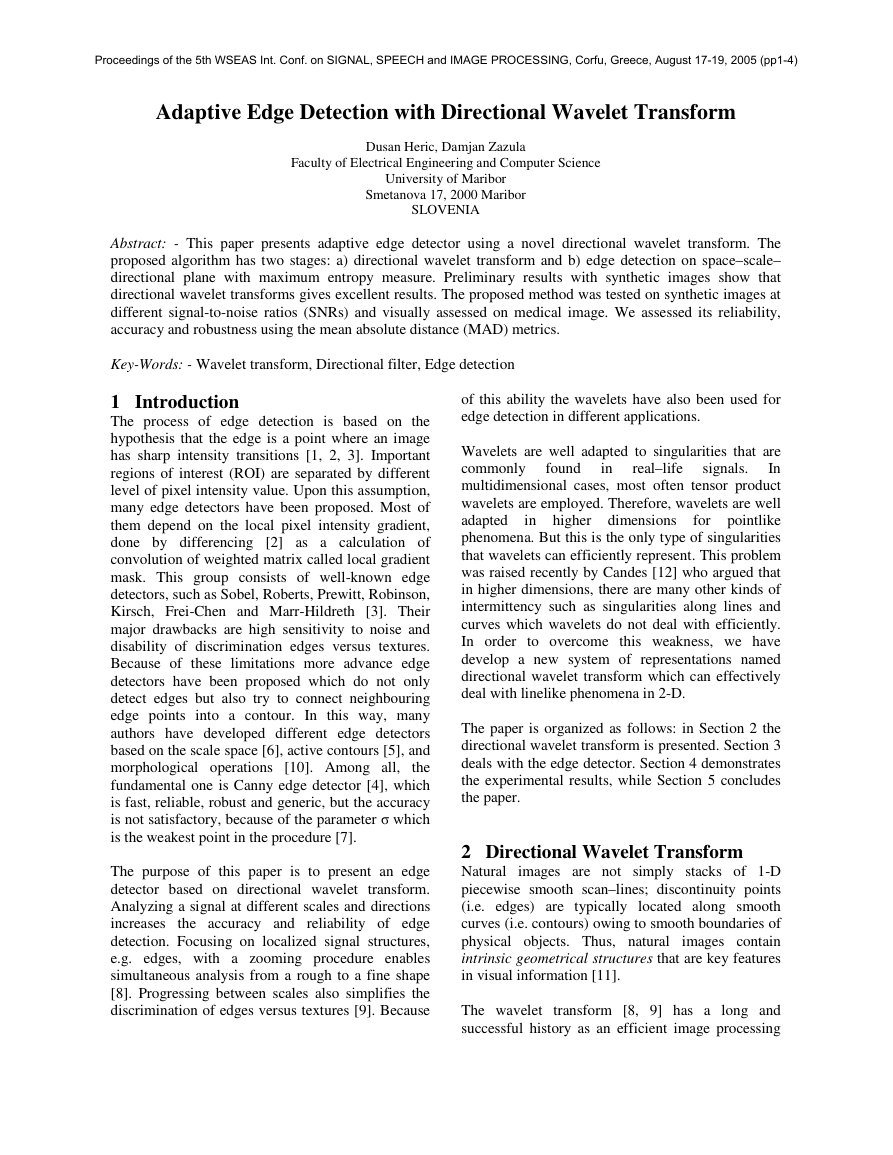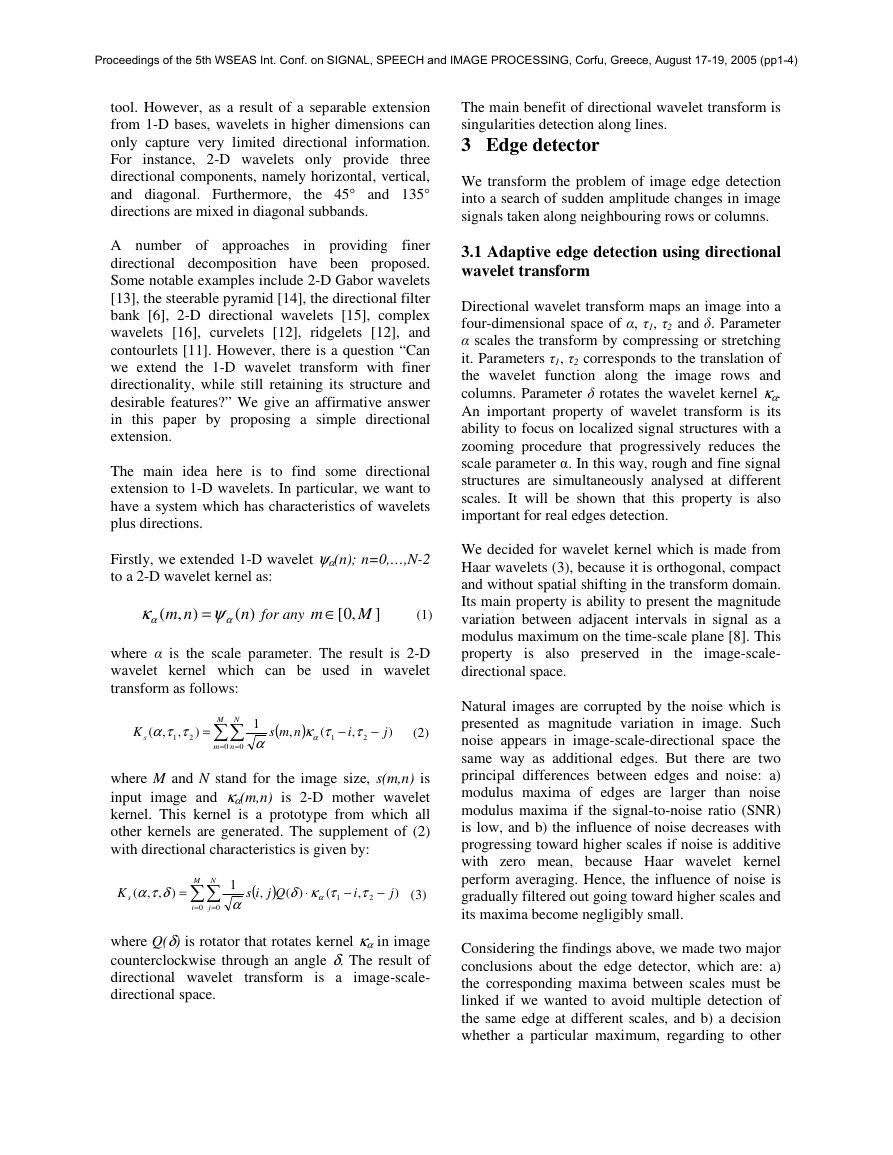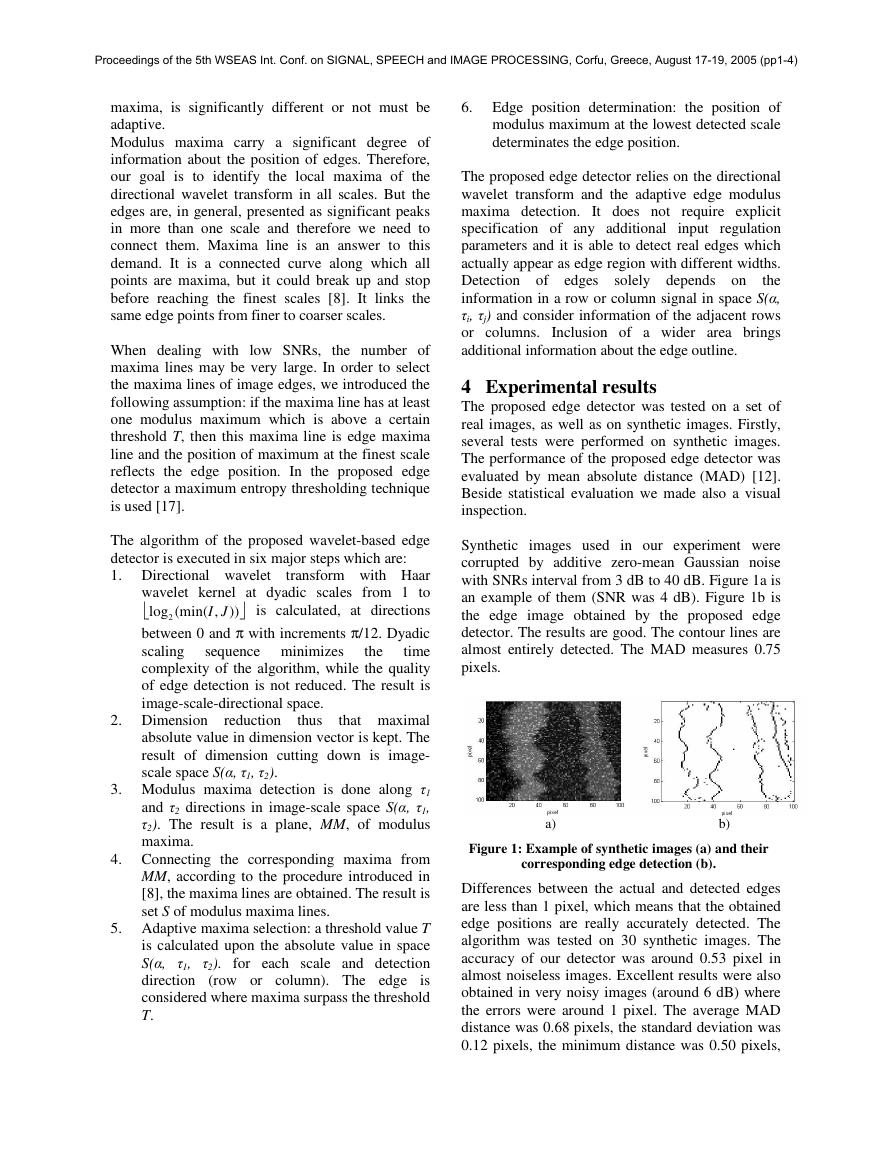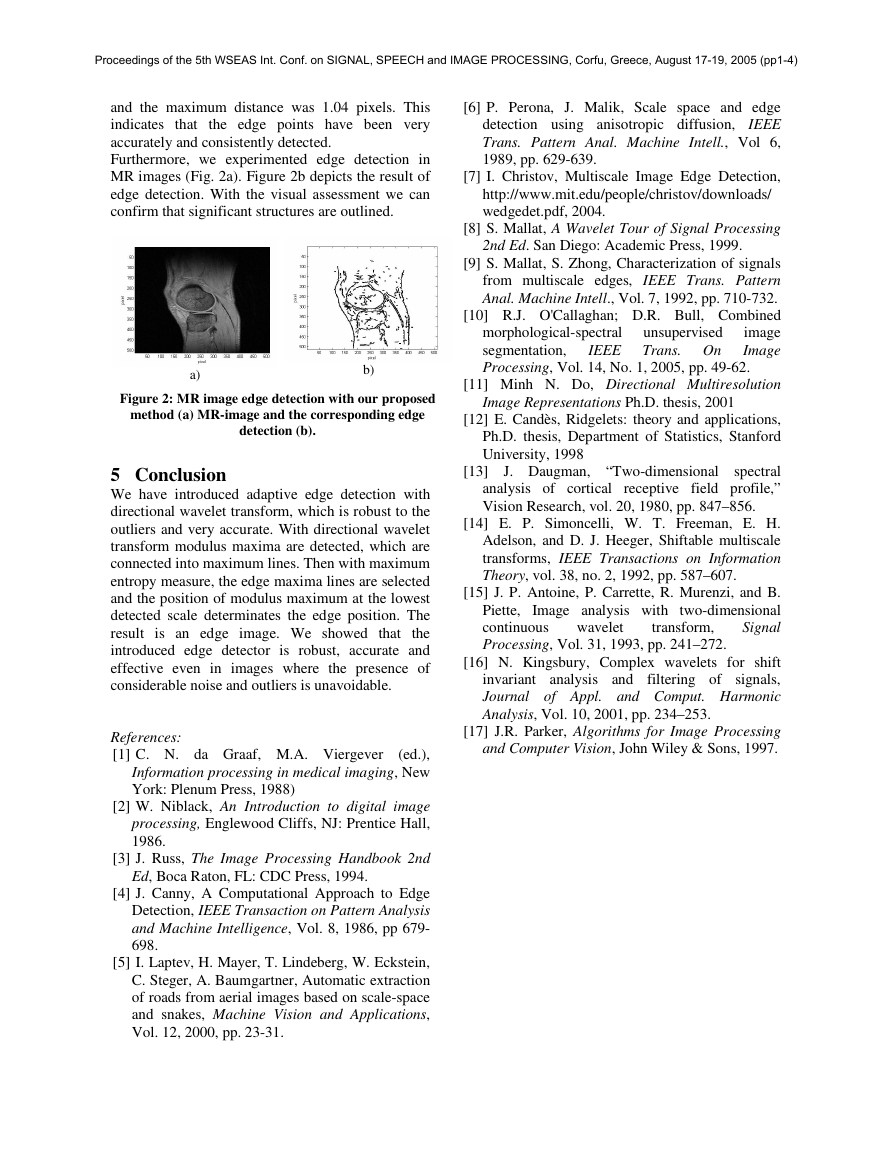Adaptive Edge Detection with Directional Wavelet Transform
Dusan Heric, Damjan Zazula
Faculty of Electrical Engineering and Computer Science
University of Maribor
Smetanova 17, 2000 Maribor
SLOVENIA
found
in
real–life
signals.
in higher dimensions
Abstract: - This paper presents adaptive edge detector using a novel directional wavelet transform. The
proposed algorithm has two stages: a) directional wavelet transform and b) edge detection on space–scale–
directional plane with maximum entropy measure. Preliminary results with synthetic images show that
directional wavelet transforms gives excellent results. The proposed method was tested on synthetic images at
different signal-to-noise ratios (SNRs) and visually assessed on medical image. We assessed its reliability,
accuracy and robustness using the mean absolute distance (MAD) metrics.
Key-Words: - Wavelet transform, Directional filter, Edge detection
1 Introduction
The process of edge detection is based on the
hypothesis that the edge is a point where an image
has sharp intensity transitions [1, 2, 3]. Important
regions of interest (ROI) are separated by different
level of pixel intensity value. Upon this assumption,
many edge detectors have been proposed. Most of
them depend on the local pixel intensity gradient,
done by differencing [2] as a calculation of
convolution of weighted matrix called local gradient
mask. This group consists of well-known edge
detectors, such as Sobel, Roberts, Prewitt, Robinson,
Kirsch, Frei-Chen and Marr-Hildreth [3]. Their
major drawbacks are high sensitivity to noise and
disability of discrimination edges versus textures.
Because of these limitations more advance edge
detectors have been proposed which do not only
detect edges but also try to connect neighbouring
edge points into a contour. In this way, many
authors have developed different edge detectors
based on the scale space [6], active contours [5], and
morphological operations [10]. Among all, the
fundamental one is Canny edge detector [4], which
is fast, reliable, robust and generic, but the accuracy
is not satisfactory, because of the parameter σ which
is the weakest point in the procedure [7].
The purpose of this paper is to present an edge
detector based on directional wavelet transform.
Analyzing a signal at different scales and directions
increases the accuracy and reliability of edge
detection. Focusing on localized signal structures,
e.g. edges, with a zooming procedure enables
simultaneous analysis from a rough to a fine shape
[8]. Progressing between scales also simplifies the
discrimination of edges versus textures [9]. Because
of this ability the wavelets have also been used for
edge detection in different applications.
Wavelets are well adapted to singularities that are
commonly
In
multidimensional cases, most often tensor product
wavelets are employed. Therefore, wavelets are well
adapted
for pointlike
phenomena. But this is the only type of singularities
that wavelets can efficiently represent. This problem
was raised recently by Candes [12] who argued that
in higher dimensions, there are many other kinds of
intermittency such as singularities along lines and
curves which wavelets do not deal with efficiently.
In order to overcome this weakness, we have
develop a new system of representations named
directional wavelet transform which can effectively
deal with linelike phenomena in 2-D.
The paper is organized as follows: in Section 2 the
directional wavelet transform is presented. Section 3
deals with the edge detector. Section 4 demonstrates
the experimental results, while Section 5 concludes
the paper.
2 Directional Wavelet Transform
Natural images are not simply stacks of 1-D
piecewise smooth scan–lines; discontinuity points
(i.e. edges) are typically located along smooth
curves (i.e. contours) owing to smooth boundaries of
physical objects. Thus, natural images contain
intrinsic geometrical structures that are key features
in visual information [11].
The wavelet transform [8, 9] has a long and
successful history as an efficient image processing
Proceedings of the 5th WSEAS Int. Conf. on SIGNAL, SPEECH and IMAGE PROCESSING, Corfu, Greece, August 17-19, 2005 (pp1-4)�
in providing
tool. However, as a result of a separable extension
from 1-D bases, wavelets in higher dimensions can
only capture very limited directional information.
For instance, 2-D wavelets only provide three
directional components, namely horizontal, vertical,
and diagonal. Furthermore,
the 45° and 135°
directions are mixed in diagonal subbands.
A number of approaches
finer
directional decomposition have been proposed.
Some notable examples include 2-D Gabor wavelets
[13], the steerable pyramid [14], the directional filter
bank [6], 2-D directional wavelets [15], complex
wavelets [16], curvelets [12], ridgelets [12], and
contourlets [11]. However, there is a question “Can
we extend the 1-D wavelet transform with finer
directionality, while still retaining its structure and
desirable features?” We give an affirmative answer
in this paper by proposing a simple directional
extension.
The main idea here is to find some directional
extension to 1-D wavelets. In particular, we want to
have a system which has characteristics of wavelets
plus directions.
Firstly, we extended 1-D wavelet ψα(n); n=0,…,N-2
to a 2-D wavelet kernel as:
κ
α
(
),
nm
=
ψ
α
)(
n
for any
m ∈
,0[ M
]
(1)
where α is the scale parameter. The result is 2-D
wavelet kernel which can be used in wavelet
transform as follows:
K
s
ττα
(
2
,
,
1
)
=
N
M
∑∑
m
=
0
n
=
0
(
nms
,
1
α
)
τκ
1
α
(
−
i
τ
,
2
−
j
)
(2)
where M and N stand for the image size, s(m,n) is
input image and κα(m,n) is 2-D mother wavelet
kernel. This kernel is a prototype from which all
other kernels are generated. The supplement of (2)
with directional characteristics is given by:
K
s
δτα
(
)
,
,
=
N
M
∑∑
i
=
0
j
=
0
(
is
,
)
Qj
1
α
τκδ
)(
1
α
(
⋅
−
i
τ
,
2
−
j
)
(3)
where Q(δ) is rotator that rotates kernel κα in image
counterclockwise through an angle δ. The result of
directional wavelet transform is a image-scale-
directional space.
The main benefit of directional wavelet transform is
singularities detection along lines.
3 Edge detector
We transform the problem of image edge detection
into a search of sudden amplitude changes in image
signals taken along neighbouring rows or columns.
3.1 Adaptive edge detection using directional
wavelet transform
Directional wavelet transform maps an image into a
four-dimensional space of α, τ1, τ2 and δ. Parameter
α scales the transform by compressing or stretching
it. Parameters τ1, τ2 corresponds to the translation of
the wavelet function along the image rows and
columns. Parameter δ rotates the wavelet kernel κα.
An important property of wavelet transform is its
ability to focus on localized signal structures with a
zooming procedure that progressively reduces the
scale parameter α. In this way, rough and fine signal
structures are simultaneously analysed at different
scales. It will be shown that this property is also
important for real edges detection.
We decided for wavelet kernel which is made from
Haar wavelets (3), because it is orthogonal, compact
and without spatial shifting in the transform domain.
Its main property is ability to present the magnitude
variation between adjacent intervals in signal as a
modulus maximum on the time-scale plane [8]. This
property is also preserved in the image-scale-
directional space.
Natural images are corrupted by the noise which is
presented as magnitude variation in image. Such
noise appears in image-scale-directional space the
same way as additional edges. But there are two
principal differences between edges and noise: a)
modulus maxima of edges are larger than noise
modulus maxima if the signal-to-noise ratio (SNR)
is low, and b) the influence of noise decreases with
progressing toward higher scales if noise is additive
with zero mean, because Haar wavelet kernel
perform averaging. Hence, the influence of noise is
gradually filtered out going toward higher scales and
its maxima become negligibly small.
Considering the findings above, we made two major
conclusions about the edge detector, which are: a)
the corresponding maxima between scales must be
linked if we wanted to avoid multiple detection of
the same edge at different scales, and b) a decision
whether a particular maximum, regarding to other
Proceedings of the 5th WSEAS Int. Conf. on SIGNAL, SPEECH and IMAGE PROCESSING, Corfu, Greece, August 17-19, 2005 (pp1-4)�
maxima, is significantly different or not must be
adaptive.
Modulus maxima carry a significant degree of
information about the position of edges. Therefore,
our goal is to identify the local maxima of the
directional wavelet transform in all scales. But the
edges are, in general, presented as significant peaks
in more than one scale and therefore we need to
connect them. Maxima line is an answer to this
demand. It is a connected curve along which all
points are maxima, but it could break up and stop
before reaching the finest scales [8]. It links the
same edge points from finer to coarser scales.
When dealing with low SNRs, the number of
maxima lines may be very large. In order to select
the maxima lines of image edges, we introduced the
following assumption: if the maxima line has at least
one modulus maximum which is above a certain
threshold T, then this maxima line is edge maxima
line and the position of maximum at the finest scale
reflects the edge position. In the proposed edge
detector a maximum entropy thresholding technique
is used [17].
The algorithm of the proposed wavelet-based edge
detector is executed in six major steps which are:
1. Directional wavelet
sequence minimizes
transform with Haar
wavelet kernel at dyadic scales from 1 to
is calculated, at directions
log2
between 0 and π with increments π/12. Dyadic
scaling
time
complexity of the algorithm, while the quality
of edge detection is not reduced. The result is
image-scale-directional space.
thus
that maximal
absolute value in dimension vector is kept. The
result of dimension cutting down is image-
scale space S(α, τ1, τ2).
reduction
the
3. Modulus maxima detection is done along τ1
and τ2 directions in image-scale space S(α, τ1,
τ2). The result is a plane, MM, of modulus
maxima.
4. Connecting the corresponding maxima from
MM, according to the procedure introduced in
[8], the maxima lines are obtained. The result is
set S of modulus maxima lines.
5. Adaptive maxima selection: a threshold value T
is calculated upon the absolute value in space
S(α, τ1, τ2). for each scale and detection
direction (row or column). The edge
is
considered where maxima surpass the threshold
T.
(min(
,
JI
))
2. Dimension
6. Edge position determination: the position of
modulus maximum at the lowest detected scale
determinates the edge position.
solely depends on
The proposed edge detector relies on the directional
wavelet transform and the adaptive edge modulus
maxima detection. It does not require explicit
specification of any additional input regulation
parameters and it is able to detect real edges which
actually appear as edge region with different widths.
Detection of edges
the
information in a row or column signal in space S(α,
τi, τj) and consider information of the adjacent rows
or columns. Inclusion of a wider area brings
additional information about the edge outline.
4 Experimental results
The proposed edge detector was tested on a set of
real images, as well as on synthetic images. Firstly,
several tests were performed on synthetic images.
The performance of the proposed edge detector was
evaluated by mean absolute distance (MAD) [12].
Beside statistical evaluation we made also a visual
inspection.
Synthetic images used in our experiment were
corrupted by additive zero-mean Gaussian noise
with SNRs interval from 3 dB to 40 dB. Figure 1a is
an example of them (SNR was 4 dB). Figure 1b is
the edge image obtained by the proposed edge
detector. The results are good. The contour lines are
almost entirely detected. The MAD measures 0.75
pixels.
a)
b)
Figure 1: Example of synthetic images (a) and their
corresponding edge detection (b).
Differences between the actual and detected edges
are less than 1 pixel, which means that the obtained
edge positions are really accurately detected. The
algorithm was tested on 30 synthetic images. The
accuracy of our detector was around 0.53 pixel in
almost noiseless images. Excellent results were also
obtained in very noisy images (around 6 dB) where
the errors were around 1 pixel. The average MAD
distance was 0.68 pixels, the standard deviation was
0.12 pixels, the minimum distance was 0.50 pixels,
Proceedings of the 5th WSEAS Int. Conf. on SIGNAL, SPEECH and IMAGE PROCESSING, Corfu, Greece, August 17-19, 2005 (pp1-4)�
and the maximum distance was 1.04 pixels. This
indicates that the edge points have been very
accurately and consistently detected.
Furthermore, we experimented edge detection in
MR images (Fig. 2a). Figure 2b depicts the result of
edge detection. With the visual assessment we can
confirm that significant structures are outlined.
[6] P. Perona, J. Malik, Scale space and edge
detection using anisotropic diffusion, IEEE
Trans. Pattern Anal. Machine Intell., Vol 6,
1989, pp. 629-639.
[7] I. Christov, Multiscale Image Edge Detection,
http://www.mit.edu/people/christov/downloads/
wedgedet.pdf, 2004.
[8] S. Mallat, A Wavelet Tour of Signal Processing
2nd Ed. San Diego: Academic Press, 1999.
[9] S. Mallat, S. Zhong, Characterization of signals
from multiscale edges, IEEE Trans. Pattern
Anal. Machine Intell., Vol. 7, 1992, pp. 710-732.
[10] R.J. O'Callaghan; D.R. Bull, Combined
image
Image
morphological-spectral
segmentation,
IEEE
Processing, Vol. 14, No. 1, 2005, pp. 49-62.
unsupervised
Trans. On
[11] Minh N. Do, Directional Multiresolution
Image Representations Ph.D. thesis, 2001
[12] E. Candès, Ridgelets: theory and applications,
Ph.D. thesis, Department of Statistics, Stanford
University, 1998
[13] J. Daugman, “Two-dimensional spectral
analysis of cortical receptive field profile,”
Vision Research, vol. 20, 1980, pp. 847–856.
[14] E. P. Simoncelli, W. T. Freeman, E. H.
Adelson, and D. J. Heeger, Shiftable multiscale
transforms, IEEE Transactions on Information
Theory, vol. 38, no. 2, 1992, pp. 587–607.
[15] J. P. Antoine, P. Carrette, R. Murenzi, and B.
Piette, Image analysis with two-dimensional
continuous
Signal
Processing, Vol. 31, 1993, pp. 241–272.
transform,
wavelet
[16] N. Kingsbury, Complex wavelets for shift
invariant analysis and filtering of signals,
Journal of Appl. and Comput. Harmonic
Analysis, Vol. 10, 2001, pp. 234–253.
[17] J.R. Parker, Algorithms for Image Processing
and Computer Vision, John Wiley & Sons, 1997.
a)
b)
Figure 2: MR image edge detection with our proposed
method (a) MR-image and the corresponding edge
detection (b).
5 Conclusion
We have introduced adaptive edge detection with
directional wavelet transform, which is robust to the
outliers and very accurate. With directional wavelet
transform modulus maxima are detected, which are
connected into maximum lines. Then with maximum
entropy measure, the edge maxima lines are selected
and the position of modulus maximum at the lowest
detected scale determinates the edge position. The
result is an edge image. We showed that the
introduced edge detector is robust, accurate and
effective even in images where the presence of
considerable noise and outliers is unavoidable.
References:
[1] C. N. da Graaf, M.A. Viergever
(ed.),
Information processing in medical imaging, New
York: Plenum Press, 1988)
[2] W. Niblack, An Introduction to digital image
processing, Englewood Cliffs, NJ: Prentice Hall,
1986.
[3] J. Russ, The Image Processing Handbook 2nd
Ed, Boca Raton, FL: CDC Press, 1994.
[4] J. Canny, A Computational Approach to Edge
Detection, IEEE Transaction on Pattern Analysis
and Machine Intelligence, Vol. 8, 1986, pp 679-
698.
[5] I. Laptev, H. Mayer, T. Lindeberg, W. Eckstein,
C. Steger, A. Baumgartner, Automatic extraction
of roads from aerial images based on scale-space
and snakes, Machine Vision and Applications,
Vol. 12, 2000, pp. 23-31.
Proceedings of the 5th WSEAS Int. Conf. on SIGNAL, SPEECH and IMAGE PROCESSING, Corfu, Greece, August 17-19, 2005 (pp1-4)�








 2023年江西萍乡中考道德与法治真题及答案.doc
2023年江西萍乡中考道德与法治真题及答案.doc 2012年重庆南川中考生物真题及答案.doc
2012年重庆南川中考生物真题及答案.doc 2013年江西师范大学地理学综合及文艺理论基础考研真题.doc
2013年江西师范大学地理学综合及文艺理论基础考研真题.doc 2020年四川甘孜小升初语文真题及答案I卷.doc
2020年四川甘孜小升初语文真题及答案I卷.doc 2020年注册岩土工程师专业基础考试真题及答案.doc
2020年注册岩土工程师专业基础考试真题及答案.doc 2023-2024学年福建省厦门市九年级上学期数学月考试题及答案.doc
2023-2024学年福建省厦门市九年级上学期数学月考试题及答案.doc 2021-2022学年辽宁省沈阳市大东区九年级上学期语文期末试题及答案.doc
2021-2022学年辽宁省沈阳市大东区九年级上学期语文期末试题及答案.doc 2022-2023学年北京东城区初三第一学期物理期末试卷及答案.doc
2022-2023学年北京东城区初三第一学期物理期末试卷及答案.doc 2018上半年江西教师资格初中地理学科知识与教学能力真题及答案.doc
2018上半年江西教师资格初中地理学科知识与教学能力真题及答案.doc 2012年河北国家公务员申论考试真题及答案-省级.doc
2012年河北国家公务员申论考试真题及答案-省级.doc 2020-2021学年江苏省扬州市江都区邵樊片九年级上学期数学第一次质量检测试题及答案.doc
2020-2021学年江苏省扬州市江都区邵樊片九年级上学期数学第一次质量检测试题及答案.doc 2022下半年黑龙江教师资格证中学综合素质真题及答案.doc
2022下半年黑龙江教师资格证中学综合素质真题及答案.doc